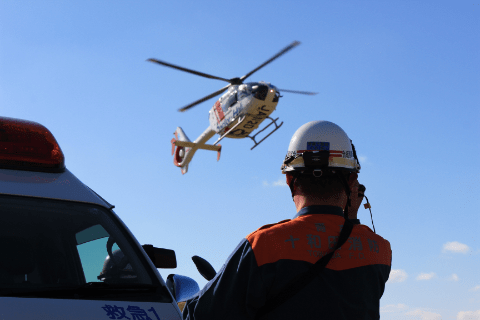A Doctor Helicopter brings a Flight Doctor and Flight Nurse to the scene of an emergency.
When a 119 emergency call comes in at the Fire-fighting Central Command Room, an ambulance is dispatched to the scene, meanwhile the request for Doctor Helicopter dispatch is sent to a base hospital. The Doctor Helicopter carrying a Flight Doctor and a Flight Nurse onboard lands at the Rendezvous Point*, the Flight Doctor and the Flight Nurse get into the ambulance, and they immediately begin treating the patient. The Doctor Helicopter service uses light twin engines class helicopter for a better maneuverability to land in confined spaces such as school yards, parks, or vacant lots.
As well as these emergency dispatches, Doctor Helicopter also transport patients from one medical institution to another as interfacility transport. In most cases, this is to transport patients to medical institutions that provide more advanced medical care.
* Rendezvous Points: The locations (points) where an ambulance and a Doctor Helicopter can meet up. They are locations for landing and take off at the emergency scene and are selected in advance by the Flight Coordination Committee in each prefecture. The committee has selected locations such as schoolyards, parking lots and parks. HEM-Net survey has found there are 625 Rendezvous Points per base hospital, as of the end of March 2017.



